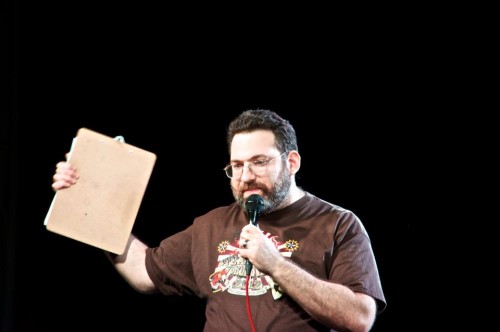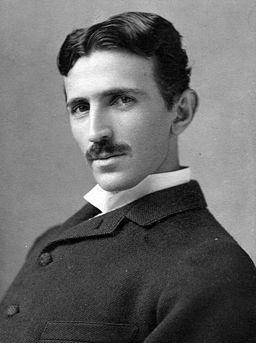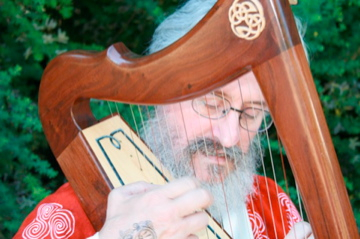What do Druidry, the Steampunk Movement, Nikola Tesla, Isaac Bonewits and Staten Island all have in common?
Answer: Jeff Mach

Jeff Mach
Jeff Mach is a modern Druid and founder of New Jersey-based Widdershins, LLC (a.k.a. Jeff Mach Events), the production company behind the popular Steampunk World’s Fair, Wicked Faire and other similarly-themed events. More recently, he began producing The Geek Creation Show, a fundraising event to benefit the Tesla Museum at Wardenclyffe on Staten Island. The Museum will be a science learning center at the reconstructed laboratory of famed-scientist, Nikola Tesla. By raising these funds, Mach is able to give something back to the local community. However, he also has an entirely unexpected motivation – one deriving from his spirituality.
Mach discovered Paganism while attending college at Rutgers University. In 1994 he helped to organize the Rutgers University Pagan Students Association, now the oldest continuously operating pagan student organization in the country. With time, Mach found his calling in modern Druidry and became a member of Ár nDraíocht Féin: A Druid Fellowship (ADF.) He says:
I identify with the idea … that there’s something powerful [in] not simply in trying to see or be what Druids were, but in the strength of taking an ancient name and concept and using its connotations in the modern world. I identify with the idea that being a Druid doesn’t simply mean that some of my worship is, say, modeled after the ancient Celts – it also means that I identify with the things that “Druid” implies to the modern world.
Identifying the power of the historical within modern life is a theme that carries over from Mach’s spiritual practice to his mundane work. One of his more popular events is the Steampunk World’s Fair, one of the biggest events of its kind in the world. Through this event and others like it, Mach attempts to capture “what was” within the spectacle of modern day. Mach explains:
In the rise of Steampunk, I see a chance to open a gate to an impossible place, and to play and maybe even, to some extent, live in that impossible place. I think that may be part of why our Steampunk event, The Steampunk World’s Fair, became the largest; we weren’t looking to study Steampunk or to make a more immersive imaginary place (though both of those are perfectly fine pursuits) – we were looking to try to summon the feeling, the whimsy, the curious world of Steampunk into this world for a weekend.
Acknowledging a definitive link between his adoration for Steampunk, the event’s coordination, and his spirituality, he says:
I’m interested in liminal spaces, in places between what we think of as “this world”, and other worlds, and I’m absolutely fascinated by Renaissance Faires, Rocky Horror – any place that we change by changing will and perception. The standard ADF liturgy takes a symbolic fire, well, and tree, and says, “Now, lord of ways, join your magic with mine and let the fire open as a gate, let the well open as a gate, let the tree be the crossroads of all worlds. Open as a road to our voices and to the spirits.” And then we open the gates. As a Pagan, I consider this holy, sacred, and real. I wouldn’t say I’d call Renaissance Faires, Rocky, or Steampunk holy or sacred in the same way – but entering each of them is an act of Magick, and I consider that world-change to be real.
Through the building of these worlds, Mach has found a way to express what he experiences through religious practice. In addition, there is a marked underlying theme. All of his events, to one degree or another showcase technology or science, from the glorification of the steam age to a workshop on bio-luminescence. As such it is not surprising that Mach decided to create another “Geeky” event to raise money for the the Tesla Museum.
 Nikola Tesla was a Serbian scientist and engineer who lived from 1856-1943. When he first arrived in the United States, Tesla worked alongside Thomas Edison. Eventually Tesla went solo, producing an enormous number of patents and technological advances. He is best known for the alternating-current. Unfortunately Tesla never gained financial backing equal to that of his contemporary, Edison. His enigmatic methodologies and personal eccentricities attracted attention but not in the way of consistent support. Regardless, his name has become synonymous with progressive thinking and innovation.
Nikola Tesla was a Serbian scientist and engineer who lived from 1856-1943. When he first arrived in the United States, Tesla worked alongside Thomas Edison. Eventually Tesla went solo, producing an enormous number of patents and technological advances. He is best known for the alternating-current. Unfortunately Tesla never gained financial backing equal to that of his contemporary, Edison. His enigmatic methodologies and personal eccentricities attracted attention but not in the way of consistent support. Regardless, his name has become synonymous with progressive thinking and innovation.
Mach calls Tesla a “visionary” and explains:
Nikola Tesla… might as well have been the archetype for Clarke’s Law: “Any sufficiently advanced technology is indistinguishable from magic.” What if part of our fascination with Tesla, with his ability to conceptualize energy sources in his head, with his uniquely intuitive leaps about where the physical world might go, is because there’s something very much akin to “magick” in the science of Tesla? A magick which is completely grounded in what we think of as “modern science”, but which doesn’t deny room for gaps in knowledge, for possibility, and for, as Crowley put it “change in accordance with Will”?
Preserving Tesla’s legacy is yet another natural extension of Mach’s spiritual beliefs. In the 1937 article “A Machine to End War,” Tesla himself says, “There is no conflict between the ideal of religion and the ideal of science…To me, the universe is simply a great machine which never came into being and never will end.” Mach agrees and, to further explain, fondly recalls several inspiring conversations with ADF Founder Isaac Bonewits, who also saw the interconnectedness between science and religion.
One of the last things [Isaac] and I talked about was education – particularly about the modern concept of education wherein religion and science were in two very different paths, and you either had education which ignored religion altogether…or which bent science for religion… One of the messages that I took from [Isaac] was the idea that if Paganism were to think of itself as having a mission, perhaps that might not be evangelism… nor separatism…but education. Let’s see if we can examine the way people look at the material, emotional, and spiritual worlds, and see if there might be more intermingling than we’d thought.

Isaac Bonewits
Influenced by Randall Styers book Making Magic: Religion Magic Science in the Modern World, Bonewits contemplated the “intermingling” of the disciplines. In his own essay entitled “Scientism on Competing Faiths,” Bonewits wrote:
…. although it’s true that the hard sciences don’t really support conservative monotheistic doctrines anymore, ever since Einstein all the sciences have tended more and more towards multi-model, pluralistic theories [rather than dualistic] that fit very well indeed with polytheism and traditional concepts of non-monotheistic occultism. This makes it sad that even people who have consciously rejected conservative monotheism are reluctant to let go of certain Scientistic prejudices, especially those concerning materialism and the nature of reality….
In an unpublished essay, Bonewits very clearly illustrates how the three “spheres of comprehension” (art, science, religion) have been progressively pulled apart by an evolving dualistic human culture.

- Copyright 2007 by Isaac Bonewits. From an unfinished essay published with permission from Phaedra Bonewits.
The Venn diagram above is labeled “modernist” meaning the contemporary worldview. As shown, science and religion do not touch at all. At the intersection of the spheres, Bonewits places magic(k) which is at its most powerful when all three intersect. However, as Bonewits laments, there is a measurable loss of powerful magic within our current dualistic world-view in which the expansion of one sphere happens at the expense of the other.
Bonewits was an inspiration to Mach and that spirit has continued fueled his work. Raising money for the Tesla museum through the creation of a “world outside of space and time” is an extension of that inspiration. It is more than just a “nice thing to do for the community.” He says:
I’m fascinated with what a Tesla museum might be, and with what it might mean for a Pagan world to acknowledge the intuitive, the leaping, and the intangible sides of the world of science – not just the purely material.
The next Tesla fundraising event will be held in November in Piscataway, New Jersey. Interest in the Geek Creation Show is, as Mach says, “picking up steam” and he hopes to be making a sizable donation to the Museum in the near future.

North side of Tesla’s Wardenclyffe lab and future Tesla Museum
The Wild Hunt is not responsible for links to external content.
To join a conversation on this post:
Visit our The Wild Hunt subreddit! Point your favorite browser to https://www.reddit.com/r/The_Wild_Hunt_News/, then click “JOIN”. Make sure to click the bell, too, to be notified of new articles posted to our subreddit.
Then I’m guessing that Tesla knew my distant cousin Cyrus Fogg Brackett, M.D. who also worked with Edison for some while, and then went on to become the founder of the Princeton University College of Electrical Engineering (I think I got that name right).
“The religion of the future will be a cosmic religion. It should transcend a personal God and avoid dogmas and theology. Covering both natural and spiritual, it should be based on a religious sense arising from the experience of all things, natural and spiritual and a meaningful unity. Buddhism answers this description. If there is any religion that would cope with modern scientific needs, it would be Buddhism.”
Albert Einstein.
The first part of the quote is obvious. It formulates expectations towards the spiritual content any effectively working enthusiast of science must long for. But in my humble opinion Buddhism does not meet the criteria. Nature-based Pantheism does! This article sums it up very well.
Oh, by the way, the peak achievement of Greek philosophy were Protagoras and the Sophists. If the formidable gap of the Dark Ages had not existed, they would start the era of MODERN SCIENCE! They created
the foundation for empiricism, sensualism, pragmatism, positivism,
conventionalism and relativism. These topics have been resumed
freshly in modern times!
Why humanity didn’t keep up the momentum? Simply because the paradigm shifted to medieval Christian ideals (which was very diffrent then todays Christianity).
Science is often touted as absolutely objective, but as you can see binding religious/ideological content does matter. Does matter a lot!
Personally, I think that any religion can fit this criteria if it’s approached from a liberal perspective. I see religions as metaphors or active mythologies. I think cosmic religion is a state of mind, maybe, more than a specific religion. Certainly, pantheism and many Pagan religions do fit more easily into this world-view, but I would imagine that most religions are in some way compatible, if as I say they are taken as a context or a starting point rather than being taken literally or as pure dogma.
Thanks for this spectacular article. I’ve been a big fan of Tesla for years. Love the way this article hints at important ways to tie together a number of my passions.
Tesla got financial support from George Westinghouse, but wasn’t able to make it pay off. Edison may have started as a lone inventor, but many of the inventions he is famous for were incremental (and very useful) improvements on the work of others. When he was able, Edison hired assistants, and he must have been a good administrator, because the patents from the Menlo Park lab earned Edison a lot of money. He built his own companies rather than relying for support on a wealthy industrialist. Of course, being a native born American, this was easier for Edison than it would have been for Tesla.
I believe this difference in approach is why Edison’s name used to be carved on the facades of public schools and Tesla is mostly remembered as a countercultural hero. Another reason perhaps is that it doesn’t take much scientific education to understand how incandescent lights and phonographs work, while some of Tesla’s electrical inventions really do look like magic.
I would like to clarify something about science, or at least physics. The simplest expression of the motion of an object involves “laws” concerning its acceleration. The popular notion of these “laws” is that they squeeze out any role for choice on the part of the operator, but this is not the case. These “laws” leave open the initial position and the initial velocity. These parameters open a wide spectrum of choice.Far from squeezing Will out of the picture, science lays the table for it.
Science and Magick meet and then religion tries control it. The important thing is not let it.
Another great article from you, Heather.